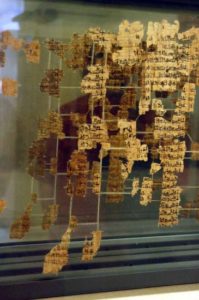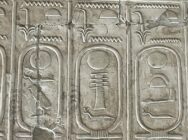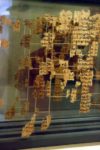
Muzeo Egizio, Turijn.
Bij het opstellen van de koningslijst, de koningskaarten en de informatie op de subpagina’s zijn de volgende bronnen geraadpleegd:
Allen, J.P. (2005). The ancient Egyptian pyramid texts. Atlanta: Society of Biblical Literature.
Baker, D. D. (2008). The encyclopedia of the egyptian pharaohs, volume I. United Kingdom: Bannerstone Press.
Beckerath, J. von. (1984). Handbuch der ägyptischen königsnamen. Meisenheim, Germany: Hain Druck.
Ben-Tor, D. (2006). Sequences and chronology of second intermediate period royal-name scarabs, based on excavated series from Egypt and the Levant. The Second Intermediate Period. 91-105.
Ben-Tor, D., Allen, S. & Allen, J. (1999). Seals and kings. BASOR, 315, p. 47-70.
Bennett, C. (2000). Bridging the second intermediate period. JAMS, 12, p. 1-21.
Bietak, M. (2010). From where came the Hyksos and where did they go? Leuven/Parijs: Peeters en Departement Oosterse Studies.
Borghardt, L. (1909). König Hu? Zeitschrift für Ägyptische Sprache und Altertumskunde (ZÄS); 46th edition, Berlin/Cairo
Broekman, G. (2011). The egyptian chronology from the start of the twenty-second until the end of the twenty-fifth dynasty: facts, suppositions and arguments. Journal of Egyptian History, 4, p. 40–80.
Clayton, P. A. (2006). Chronicle of the pharaohs. London, United Kingdom: Thames & Hudson Ltd.
Dijk, J. van. (2010). New evidence on the length of the reign of Horemheb. JARCE, 44, p. 193-200.
Dodson, A. (2021). The first pharaohs. Their lives and afterlives. Cairo, Egypt: The American University in Cairo Press.
Dodson, A. (2012). Afterglow of Empire. Cairo, Egypt: The American University in Cairo Press.
Dodson, A. (2015). Monarchs of the Nile, 3rd revised edition. Cairo, Egypt: The American University in Cairo Press.
Dodson, A. & Hilton, D. (2004). The complete royal families of ancient Egypt. London, United Kingdom: Thames & Hudson Ltd.
Drayer, G. (1998). Der erste König der 3. Dynastie. In Stationen: Beiträge zur Kulturgeschichte Ägyptens, Rainer Stadelmann gewidmet, edited by H. Guksch and D. Polz.
Grimal, N. (2005). A history of ancient Egypt. Oxford, United Kingdom: Blackwell Books.
Hamilton, C. (2016). Enlightening the Enduring Engravings: The Expeditions of Raneb. Archéo-Nil. p.184-204
Ikram, S. (2006). Dood en begrafenisrituelen in het oude Egypte. Amsterdam, Netherlands: Pearson Benelux.
James, P. & Morkot, R. (2010). Herihor’s kingship and the high priest of Amun Piankh. Journal of Egyptian History. 3.2, p. 321-257. doi: 10.1163/187416610X
Jansen-Winkeln, K. (1995). Historische probleme der 3. zwischenzeit. The Journal of Egyptian Archaeology, Vol. 81, p. 129-149.
Johnson K. & Petty B. (2011). The names of the kings of Egypt. Littleton, Amerika: Museum Tours Press.
Kahl J. (2000) Inscriptional evidence for the relative chronology of dyns. 0-2. Ancient Egypt chronology. Leiden, Netherlands: Brill
Krauss, R., Hornung, E. & Warburton, D. A. (2006). Ancient Egypt chronology. Leiden, Netherlands: Brill.
Lacher, C. (2011), The tomb of king Ninetjer at Saqqara. Egypt at its origins 3, Proceedings of the Third International Conference “Origin of the State. Predynastic and Early Dynastic Egypt”. London, 27th July – 1st August 2008
Leprohon, R.J. (2013). The Great Name, Ancient Egyptian Royal Titilary. Atlanta, Amerika: Society of biblical Literature.
Mieroop, M. van de. (2011). A history of Ancient Egypt. Hoboken, VS: Wiley-Blackwell.
Müller, H. (1938) Die formale entwicklung der titilatur der Ägyptischen könige. Glückstadt, Hamburg, New York : Verlag J.J. Augustin
Petrie, F. (1922). Tombs of the Courtiers and Oxyrhinkhos. London. British school of archeology in Egypt.
Pragt, H. (2008). De verborgen tombe. Amersfoort, Nederland: Wilco.ü
Pragt, H. & Gils, P. van. (2017). Syllabus bij de Summer School ‘De Aton-revolutie’.
Pragt, H. (2019). Egypte ontraadseld. Zutphen, Nederland: Walburg Pers.
Reynders, M. (2007). De Nijl stroomopwaarts. Leuven, Belgium: Davidsfonds.
Ryholt, K. (1997). The political situation in Egypt during the sip. Copenhagen, Denmark: Museum Tusculanum Press.
Sankiewicz, M. (—-). The ‘co-regency’ of Hatshepsut and Thutmose III in the light of iconographyin the temple of Hatshepsut at Deir el-Bahari. p. 131-142. Verkregen van http://www.academia.edu
Shaw, I. (2000). The Oxford history of ancient Egypt. Oxford, United Kingdom: Oxford University Press.
Verner, M. (2009). The pyramids. London, United Kingdom: Atlantic books.
Wilkinson, T. A. H. (1999). Early dynastic Egypt. London, United Kingdom: Routledge.
Andere bronnen:
De website van Peter Lundström http://www.pharaoh.se met diverse cartouches.
De website van Jacques Kinnaer http://www.ancient-egypt.org
Communicatie met Aidan Dodson in januari 2023 over de volgorde van de vorsten van de 3de dynastie.
Verder zijn de volgende historische bronnen geraadpleegd:
- de koningslijst van Turijn, Museo Egizio, Turijn.
- de koningslijst van Sethy I in zijn tempel in Abydos.
- de koningslijst van Ramses II, British Museum London.
- de steen van Palermo, Archeologisch Museum, Palermo.
Lees meer over deze historische bronnen op onze website www.kemet.nl

